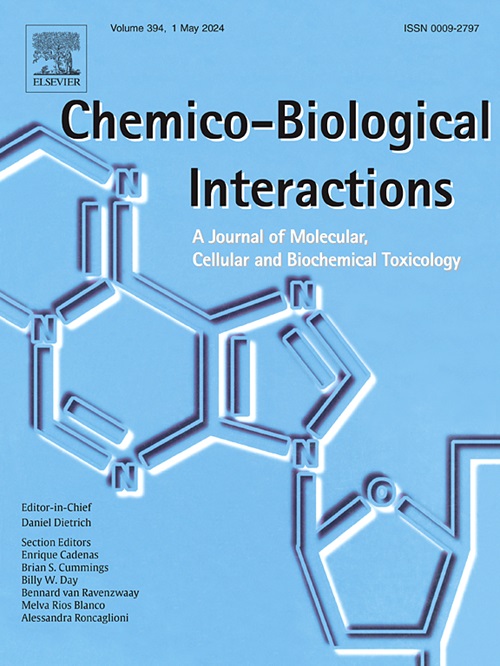聚苯乙烯微塑料通过氧化应激和Bcl-2/Bax/Caspase途径破坏肾类器官发育
IF 5.4
2区 医学
Q1 BIOCHEMISTRY & MOLECULAR BIOLOGY
引用次数: 0
摘要
微塑料(MPs),特别是聚苯乙烯微塑料(PS-MPs),已成为严重的环境污染物,对人类健康具有潜在风险。在包括血液和胎盘组织在内的人体组织中检测到它们的存在,引起了人们对发育影响的担忧。然而,MPs对人体器官发育的影响仍然是未知的。肾脏是人体排毒和排泄废物的重要器官,对有毒物质高度敏感,是毒性研究的重要焦点。为了研究肾脏的发育,人诱导多能干细胞(hiPSC)衍生的肾类器官提供了一个有用的体外模型。本研究专门研究了PS-MPs对hipsc向肾类器官分化的影响。根据1.6 μg/mL时血中检测到的PS-MPs浓度设置不同浓度的PS-MPs(0、1.25、2.5、5、10、20 μg/mL)。目的是了解环境污染物如何在细胞水平上影响肾脏发育。我们的研究结果表明,PS-MP暴露会导致肾元祖细胞损伤,并破坏肾脏发育的关键过程,包括肾元形成和上皮细胞分化。在机制上,我们证明了PS-MPs诱导线粒体氧化应激,激活Bcl-2蛋白家族,并通过Bcl-2/Bax/caspase-9/caspase-3信号通路触发细胞凋亡。这种破坏最终会损害正常肾类器官的形成。这些结果强调了PS-MPs对胚胎肾脏发育的有害影响,并强调迫切需要进一步调查人类早期发育期间微塑料暴露相关的健康风险。本文章由计算机程序翻译,如有差异,请以英文原文为准。
Polystyrene microplastics disrupt kidney organoid development via oxidative stress and Bcl-2/Bax/caspase pathway
Microplastics (MPs), particularly polystyrene microplastics (PS-MPs), have emerged as significant environmental pollutants with potential risks to human health. Their presence has been detected in human tissues, including blood and placental tissue, raising concerns about developmental effects. However, MPs’ effects on the development of human organs are still mostly unknown. The kidney is essential to detoxification and waste excretion in the body and is highly sensitive to toxic substances, making it an important focus for research on toxicity. To study kidney development, human induced pluripotent stem cell (hiPSC)-derived kidney organoids offer a useful in vitro model. This research specifically examines the consequences of PS-MPs on the differentiation of hiPSCs into kidney organoids. Different concentrations of PS-MPs (0, 1.25, 2.5, 5, 10, 20 μg/mL) were set according to the concentration of PS-MPs detected in blood at 1.6 μg/mL. The aim is to understand how environmental contaminants may impact kidney development at the cellular level. Our findings indicate that PS-MP exposure leads to nephron progenitor cell damage and disrupts key processes involved in kidney development, including nephron formation and epithelial cell differentiation. Mechanistically, we demonstrate that PS-MPs induce mitochondrial oxidative stress, activate the Bcl-2 protein family, and trigger apoptosis via the Bcl-2/Bax/caspase-9/caspase-3 signaling pathway. This disruption ultimately impairs normal kidney organoid formation. These results underscore the detrimental impact of PS-MPs on embryonic kidney development and highlight the urgent need for further investigation into the health risks associated with microplastic exposure during early human development.
求助全文
通过发布文献求助,成功后即可免费获取论文全文。
去求助
来源期刊
CiteScore
7.70
自引率
3.90%
发文量
410
审稿时长
36 days
期刊介绍:
Chemico-Biological Interactions publishes research reports and review articles that examine the molecular, cellular, and/or biochemical basis of toxicologically relevant outcomes. Special emphasis is placed on toxicological mechanisms associated with interactions between chemicals and biological systems. Outcomes may include all traditional endpoints caused by synthetic or naturally occurring chemicals, both in vivo and in vitro. Endpoints of interest include, but are not limited to carcinogenesis, mutagenesis, respiratory toxicology, neurotoxicology, reproductive and developmental toxicology, and immunotoxicology.

 求助内容:
求助内容: 应助结果提醒方式:
应助结果提醒方式:


